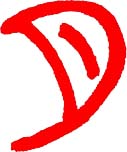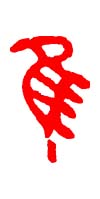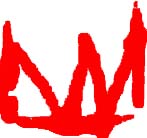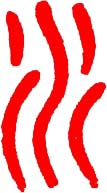Q & A
Q: Why is the Chinese writing system so special compared to other writing systems?
A: About 4000 years ago, the
Chinese people began to create their writing system. It is the only
major writing system that went through a pictographic stage, and then
maintained a pictographic component as the written language developed.
Many of the original pictographs can still be seen in modern use.
In contrast, most of the world’s writing systems eventually developed
phonetic alphabets to represent the sounds of spoken language rather than
visual images perceived in the physical world. As the written language
developed, another major method for creating characters was introduced:
combining a component indicating semantic class (e.g. ”metal” or “plant”)
with a phonetic component. Over 80% of Chinese characters were formed
in this way. Such Chinese characters incorporate meaning and sound
as well as visual image in each individual character.
There are about 50,000 Chinese characters. To read a daily newspaper,
one must memorize about 3000 - 4000 characters. Well-educated individuals
master 6000 – 7000 characters.
Q: Are Chinese characters very difficult to learn?
A: If you are familiar with
the principles governing the composition of the Chinese characters, you
will find it is very easy to remember even the most complicated looking
character, and you will find that it is one of the most beautiful, logical,
and scientifically constructed writing systems in the world.
Traditional Chinese etymology postulates six principles known as the “Liu
shu”. Chinese characters have been classified into six categories:
Pictograms - imitating the form of concrete object (4%)
 |
 |
 |
 |
 |
 |
 |
 |
|
Elephant
|
Moon
|
Sun
|
Bird
|
Mountain
|
Water
|
Fish
|
Car
|
Ideograms - the symbols of abstracts notions (1%)
 |
 |
 |
 |
 |
 |
|
Up
|
Down
|
Protrusion
|
Indention
|
End
|
Root
|
Composite Ideograms - understanding the meaning (13%)
 |
 |
 |
 |
 |
 |
|
East
|
Public
|
Bright
|
Man
|
Early
|
Sit
|
Composite Phonograms - using of one
component to indicate meaning and the other to indicate sound of the
character (82%)
 |
 |
 |
 |
 |
 |
 |
|
Grace
|
Fragrant
|
Pavillion
|
Solid,
Firm
|
To
Knot, Tie
|
To
Inquire
|
To
Soar
|
Mutually Defining - using of synonymous
characters
 |
 |
 |
 |
 |
|
Papa
|
Daddy
|
Deceased
Father
|
Elderly,
Old
|
None
|
Borrowing – concerning the loan of
hormophones
 |
 |
 |
 |
 |
|
Back
|
Come
|
Wheat
|
Beautiful
|
To
Grow
|
Q: How many styles of Chinese calligraphy are there?
A: Chinese calligraphy already showed a marked aesthetic consciousness on Oracle Bone Inscription and Bronze Inscription as early as Shang & Zhou period (ca. BC 1800 – BC249). However, it was not regarded as art in the way we regard “art” in our modern 21st century. Not until the East-Han period, Chinese calligraphy becomes an art for aesthetic appreciation and study. Based on Oracle Bone Inscription, five basic styles emerged.
| v Oracle Bone Inscription | ca. 1800-1122 BC | ||||||
| v Bronze Inscription | ca. 1122-249 BC | ||||||
| v Seal – Style (zhuàn shū) |  |
ca. 221-206 BC | |||||
| · Greater Seal (dà zhuàn) | |||||||
| · Lesser Seal (xiăo zhuàn) | |||||||
| v Clerical – Style (lì shū) | ca. 221-209 BC | ||||||
| v Standard - Style (kăi shū) | ca. 221-580 AD | ||||||
| v Running – Style (xíng shū) |  |
ca. 265–313 AD | |||||
| · Running Standard (xíng kăi) | |||||||
| · Running Cursive (xíng căo) | |||||||
| v Cursive - Style (căo shū) |  |
ca. BC 60 | |||||